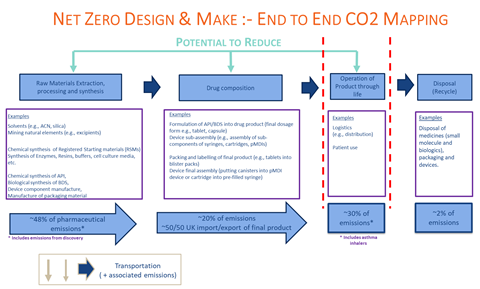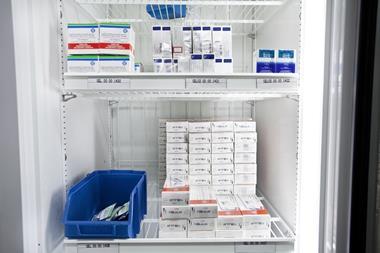The pharmaceutical industry is taking action towards net zero
In the wake of Cop26, fresh new pledges to achieve net zero have come thick and fast. Energy, automotive and foundation industries (those producing raw materials such as metals, chemicals and cement) are typically under the most scrutiny. However, the pharmaceutical industry also has a role to play. Encouragingly, the majority of big pharma companies now have ambitious net zero targets, strategies and initiatives in place. For example, AstraZeneca’s Ambition Zero Carbon strategy, which aims to be carbon negative across the entire value chain by 2030.
The pharmaceutical industry produces an estimated equivalent of 52 million tonnes of carbon dioxide in greenhouse gas emissions every year, accounting for around 2% of industrial greenhouse gas emissions. Surprisingly, pharma is 13% more polluting than the automotive industry despite being 28% smaller. Products such as inhalers or those that use hot water to dissolve medication have very large carbon footprints (inhalers account for about 30% of GlaxoSmithKline’s emissions). In the UK, the pharmaceutical carbon footprint makes up about 22% of National Health Service (NHS) emissions, equating to 1% of the UK’s overall total.
Emissions mapping

To comply with the Paris Agreement’s target to limit global average temperature to 1.5°C above pre-industrial temperatures, the pharmaceutical industry would need to reduce greenhouse gas emissions by 59% by 2025. The first steps towards net zero include establishing targets (such as the Science Based Targets initiative’s Net-Zero Standard) and understanding and quantifying the emissions across the supply chain. However, the complexity of medicine supply chains poses specific challenges in acquiring and reporting information about the environmental impacts. It can be difficult to get accurate carbon reporting from suppliers, with attempts often further complicated by confidentiality concerns.
An environmentally extended input-output analysis conducted by Small World Consulting modelled the source of the UK pharmaceutical sector greenhouse gas footprint, and the industries in which they are generated. Notably, the most carbon-significant materials identified were petrochemicals (10%), agricultural products (9%), basic iron and steel (6%) and industrial gasses (5%). Alone, these make up nearly a third of UK pharmaceutical emissions and highlight the cross-sectorial and global challenge with carbon accounting. Measuring only the impacts of pharmaceutical companies would be misleading; we need an industry-standard method for tracking and accounting for embodied emissions across supply chains.
The UK industrial decarbonisation strategy similarly identified the need for data transparency and data standards, with a call for evidence on low carbon industrial products to be conducted in the next 12 months. Voluntary product standards will potentially be introduced by 2025.TheNHS is the world’s first health service to commit to reaching net zero carbon emissions, and will launch the NHS sustainable supplier framework next year. By April 2024, all new NHS suppliers will need to publish a carbon reduction plan for direct emissions. By 2030 suppliers will only qualify for NHS contracts if they can demonstrate progress through carbon emissions reporting in line with the supplier framework.
Consumer and patient behaviour can also help to drive the decarbonisation of medicines. Medicines wastage in the UK is thought to cost the NHS over £300 million per year and it is estimated that every pound spent on pharmaceuticals generates the equivalent of 0.1558kg of carbon dioxide emissions – the equivalent of almost 47,000 tonnes of carbon dioxide a year generated through waste alone.
Opportunities and efficiencies
For the pharmaceutical industry, the challenges are significant; not only must the industry now deal with the aftermath of the Covid-19 crisis, global competition and supply chain issues, but also tackle greenhouse gas emissions and strive for carbon net zero. However, the sector appears upbeat, with many major companies now actively applying emissions reduction measures. Decarbonisation strategies typically revolve around eco-buildings, electrification of vehicle fleets, carbon offsetting and switching to renewable energy sources. However, there remain numerous other opportunities to reduce costs and improve efficiencies; for example, the new Energize initiative announced at Cop26 specifically targets supplier emissions by enabling access to renewable energy.
Important schemes such as the Green Labs Initiative are looking at ways to reduce energy, water and material consumption and waste generation in research settings. R&D laboratories consume nearly five times more energy than a typical office space due to increased equipment use, materials, computing energy and ventilation requirements. At a production level, continuous manufacturing can reduce the manufacturing carbon footprint by up to 80%. In 2014, Amgen opened a $200 million (£146 million) next generation biomanufacturing facility incorporating innovative techniques and a continuous purification system. Its modular design means the plant’s footprint is 75% smaller, with energy consumption down 69% and water consumption reduced by 45%.
Finally, a pilot study by the logistics division DHL demonstrated a 38% reduction in carbon footprint and supply chain costs for transporting pharmaceuticals by consolidating cold-chain inventory within a warehouse and shipping to wholesalers in refrigerated trucks, rather than packing products in special packaging.
Patients, industry and policymakers must work together to define the future of green medicines. Innovation in sustainable design and manufacturing combined with collaboration and international agreement on carbon accounting standards across the supply chain will provide the roadmap to net zero in pharma.
Acknowledgement
This article was written in consultation with the MMIP/ABPI Sustainability Working Group












No comments yet